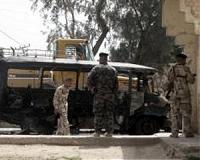| . |  |
. |
London (UPI) Jan 19, 2011 BAE Systems, Europe's largest defense company, is working on a camouflage system that could put an army of "invisible" tanks on the battlefield in the next five years. The system, called e-camouflage, involves sensors mounted to the vehicle's hull that can film and project images of the surrounding landscape on the tank and thus make it invisible, London's The Daily Telegraph wrote Wednesday, citing scientists at BAE Systems. The images would change as the tank moves, ensuring that it can dodge attacks even when moving from a barren into a vegetated environment, for example. The technology was first reported on by the newspapers Daily Telegraph, Sun and Daily Mail in October 2007, when it was being tested by the British Defense Ministry. "This technology is incredible," an unnamed soldier who was at the tests at the time was quoted by The Daily Mail. "If I hadn't been present I wouldn't have believed it. I looked across the fields and just saw grass and trees -- but in reality I was staring down the barrel of a tank gun." E-camouflage was developed as part of Britain's Future Protected Vehicles program, aimed at equipping and introducing the latest in manned and unmanned military vehicles, The Daily Telegraph said. The program includes unmanned robots, scout vehicles, infantry carriers and attack vehicles. It comes after London last year published its Strategic Defense and Security Review, which proposed significant cuts to military personnel and defense equipment, including armored vehicles. Regarding armor -- BAE Systems is also researching a novel form of body protection. Dubbed liquid armor by officials at BAE Systems, the material hardens when struck by a bullet, thus supporting existing energy absorbing properties of material structures like Kevlar, BAE Systems said in a statement. Especially in hot environments such as Afghanistan, current ceramic-based body armor wear down the soldier because it is relatively heavy. The liquid armor, due to its light weight, offers protection from bullet wounds while leaving the wearer mobile. "The technology is best explained by the example of stirring water with a spoon," Stewart Penney, a senior innovation official at BAE Systems, was quoted as saying in a company statement issued last year. "In water you feel little resistance to the spoon. Whereas with liquid armor, you would feel significant resistance as the elements in the fluid lock together. The faster you stir, the harder it gets, so when a projectile impacts the material at speed, it hardens very quickly and absorbs the impact energy."
earlier related report Boeing said it would deliver 13 C-17s in 2011, one less than the prior year, as it moves to a new annual production rate of 10. "Boeing will reduce the production program's work force by approximately 1,100 jobs through the end of 2012," the Chicago-based firm said in statement. The transition to the new production rate was announced in February 2010. The long-haul military cargo C-17, which is in its 18th year of service, can carry large equipment, supplies and troops directly to small airfields, the company says. "The fleet continues to operate at an accelerated rate due to the recent troop surge in Afghanistan," Boeing said. "It achieved two million total flight hours in December, less than five years after it passed the one-million-flight-hour mark." The US Air Force is the biggest customer, taking 206 of the 226 C-17s delivered worldwide. Boeing's foreign military customers include Britain, Canada, Australia, United Arab Emirates and Qatar, as well as the NATO-led Strategic Airlift Capability consortium. The C-17 has also supported humanitarian and disaster-relief missions, such as providing relief to Haiti in the aftermath of a devastating hurricane a year ago. Boeing said the move to a slower production rate "will be completed this summer" and lead to the elimination of the second shift at the C-17 final assembly facility in Long Beach, California. About 900 of the planned 1,100 job cuts were expected to be made at the Long Beach plant. The remainder of the reductions will occur in Arizona, Georgia and Missouri. "Reducing the number of C-17s we deliver every year -- and doing that with a smaller work force -- will allow us to keep the production line open beyond 2012, protect jobs, and give potential customers more time to finalize their airlift requirements," Bob Ciesla, C-17 program manager, said in the statement. Boeing said it was working to capture additional international orders for the C-17, and that India and Kuwait were expected to be the next customers. The Defense Department's proposed fiscal 2011 budget funds the shutdown of the C-17 program. Boeing shares were down 1.69 percent at $70.52 in midday New York trade.
Share This Article With Planet Earth
Related Links The latest in Military Technology for the 21st century at SpaceWar.com
 LockMart Receives Urban Operations Training System Contract Award
LockMart Receives Urban Operations Training System Contract AwardOrlando FL (SPX) Jan 20, 2011 The U.S. Army's Program Executive Office of Simulation, Training and Instrumentation awarded Lockheed Martin an indefinite delivery/indefinite quantity contract to provide Urban Operations Training Systems (UOTS) for the U.S. Army, Army Reserve and National Guard. The award includes an initial $22,000 delivery order with a potential value of $287 million over five years. "We believe this t ... read more |
|
| The content herein, unless otherwise known to be public domain, are Copyright 1995-2010 - SpaceDaily. AFP and UPI Wire Stories are copyright Agence France-Presse and United Press International. ESA Portal Reports are copyright European Space Agency. All NASA sourced material is public domain. Additional copyrights may apply in whole or part to other bona fide parties. Advertising does not imply endorsement,agreement or approval of any opinions, statements or information provided by SpaceDaily on any Web page published or hosted by SpaceDaily. Privacy Statement |